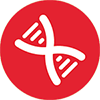Chemistry for Health and Life Sciences
 The treatment of rare and disabling diseases is one of the challenges for the health sciences of the third millennium. To pursue this goal, CNR-ICCOM carries out research activities concerning the application of magnetic nanoparticles, 2D materials and DNA sequences rich in guanine as therapeutic agents in the treatment of cancer, the application of hydrogels to contrast the degeneration of cartilage tissues. in the elderly population and the study of drugs using solid-state NMR spectroscopies. The envisaged objectives are in line with the themes of Horizon Europe 2021-2027, with the National Research Plan (2021-2027) and with the National Recovery and Resilience Plan (PNNR) which aims to help develop new therapies and methodologies of prevention and diagnosis.
The treatment of rare and disabling diseases is one of the challenges for the health sciences of the third millennium. To pursue this goal, CNR-ICCOM carries out research activities concerning the application of magnetic nanoparticles, 2D materials and DNA sequences rich in guanine as therapeutic agents in the treatment of cancer, the application of hydrogels to contrast the degeneration of cartilage tissues. in the elderly population and the study of drugs using solid-state NMR spectroscopies. The envisaged objectives are in line with the themes of Horizon Europe 2021-2027, with the National Research Plan (2021-2027) and with the National Recovery and Resilience Plan (PNNR) which aims to help develop new therapies and methodologies of prevention and diagnosis.
The activities of CNR-ICCOM, which intend to foster the development of precision medicine and less invasive approaches to the treatment of diseases, include:
- Development of magnetic nanoparticles (NPs) functionalized as therapeutic “activating” agents that allow to synergistically combine conventional (chemo-, radiotherapy) or more experimental (Hadron Terapy-HT, Boron Neutron Capture Therapy-BNCT) therapies with hyperthermia a magnetic fluid (MFH), based on the property of NPs to release heat when subjected to an alternating magnetic field;
- 2D nanomaterials for cancer study and therapy: study of the interaction of graphene oxide or molybdenum sulphide nanoflakes with cancer cells, and in particular for acute myeloid leukemia and triple negative breast cancer, through multiscale computational simulations also aimed at helping Raman imaging interpretation; study of the use of black phosphorus in prostate cancer therapy;
- Study of “G-quadruplexes” in the therapeutic approach of some rare forms of cancer, using molecular modeling techniques and computational spectroscopy to study at the atomistic level the behavior of fluorescent probes in interaction with proteins and some specific structures of nucleic acids;
- Study of hydrogels for the regeneration of cartilage tissues, through NMR relaxometry techniques, able to characterize the state of water and the state of aggregation of the polymeric matrix as a function of various parameters, of relevance for the diffusion of nutrients and the promotion cell survival and differentiation and computational methods for the prediction of circular dichroism spectra (electronic and vibrational) of enantiomers;
- Advanced methods for the characterization of new pharmaceutical preparations, through solid state nuclear magnetic resonance (ssNMR); Release of bioactive compounds through the use of hydrogels; Gold nanoparticles specialized in the release of drugs in anticancer therapies;
- Extraction and use of plant extracts (polyphenols) with antioxidant, antiviral and antibacterial activity, using innovative and low environmental impact methods specifically developed and studied in polymeric matrices;
- Development of personalized diagnoses and innovative therapies for patients with chronic lymphocytic leukemia resistant to therapies;
- New ETS-regulated biomarkers for prostate cancer diagnosis;
- Study of models for the understanding of the biochemical processes underlying the generation of chemical radicals and reactive oxygen species, with particular interest in the connection between these and neuroinflammatory and aging processes, for the early diagnosis of degenerative processes and the triggering of cascades of uncontrollable chemical reactions common to many diseases.
